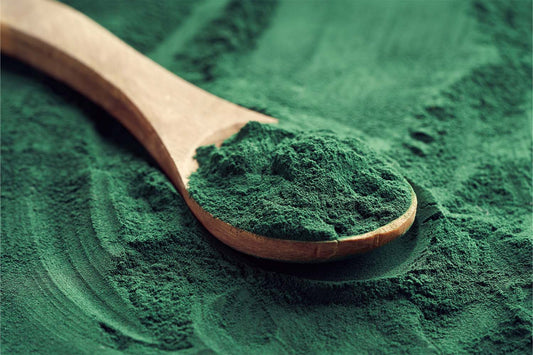If your skin doesn't look as fresh and youthful as you'd like — if you don't see clarity and radiance when you look in the mirror — you may want to evaluate your exfoliation routine.
The right type and frequency of exfoliation can help keep your skin healthy, hydrated, and renewed… and can even help your skincare products work more effectively. Let's dig in to skin cell turnover!
What Is Exfoliation and What Does It Do?

Exfoliation is the process of removing dead skin cells from the surface layer of your skin.
Your body is constantly shedding off dead cells as it produces new cells. However, these cells can build up on the surface and obstruct your outer layer of skin. Exfoliating helps to slough away these cells and free the newer skin underneath.
Exfoliation can offer many potential benefits for your skin, from improving the appearance of your skin tone to supporting healthier skin. Many people choose to exfoliate for more vibrant and clearer-looking skin.
However, exfoliating is not a one-size-fits-all process, and much of the process depends on your skin type and how your skin responds to exfoliation. The exfoliation process looks different between those with sensitive, dry, oily, or combination skin.
The two types of exfoliation are mechanical and chemical, either relying on a tool to remove dead skin cells or on a chemical product to dissolve them.
What Are Exfoliants?
Mechanical exfoliants are tools that gently scrub your skin to remove dead skin cell buildup. Some mechanical exfoliants include sponges, brushes, and facial scrubs.
While this type of exfoliant is effective, it isn’t always the best for your skin. These products can pull and tear your skin, creating even more dryness and irritation.
The chemical exfoliation process relies on ingredients to remove old skin cells and often takes the form of a toner, a treatment masque, or a peel. You’ll spot some of the following ingredients in this type of exfoliant product.
The most common chemical exfoliants include alpha hydroxy acids (AHAs) or beta hydroxy acids (BHAs). AHAs are water-soluble, improving the texture and elasticity of your skin, and BHAs are oil-soluble, helping to unclog pores and clear sebum.
Some examples of AHAs include:
- Glycolic acid
- Lactic acid
- Citric acid
Meanwhile, examples of BHAs include:
- Salicylic acid
- Tropic acid
- Trethocanic acid
Other exfoliants use enzymes to help remove dead skin cells. Enzymes are typically much gentler on the skin, and they are often derived from natural sources like fruits or bamboo. You might see an enzyme listed as papaya extract or pineapple extract.
What Are the Benefits of Exfoliation for Dry Skin?
Exfoliating has many potential benefits, but it is important to understand how the process works and how to do it correctly to maximize them. If you have dry skin, it is even more important to be mindful of how this powerful process works.
The following will tell you everything you need to know about exfoliating.
1. You Can Enjoy More Radiant Skin
By removing dead skin cells, exfoliation helps clear your skin, making it appear and feel more vibrant. Exfoliating leaves you with softer, smoother-feeling skin by eliminating the dull layer of dead skin cells on the outer part of your skin.
Clearing away dead skin cells helps revive dull skin and brighten your complexion, allowing your natural skin to shine. Part of this process involves diminishing the appearance of dark spots, leaving you with a more even skin tone and full of radiance.
Regular exfoliation also helps keep your pores clean and clear of dirt build-up, reducing your chances of developing blemishes and blackheads.
Removing old skin cell buildup can also help soften skin texture and smooth the surface of your skin. This can help your skin look and feel more radiant.
For deeper exfoliation, many people turn to their dermatologist to receive microdermabrasion. This non-invasive treatment helps remove dead skin cells and usually helps reach deeper into the skin than at-home treatments.
However, both at-home treatments and dermatologist-supported treatments can help make a difference.
2. It Can Reduce Signs of Aging
Since it has less elasticity and less resilience, dry skin is more susceptible to early signs of aging. Signs like sun damage, fine lines, and dark spots also contribute to the effects of aging, adding to the dryness.
By removing dead skin cells, exfoliating helps to smoothen the texture of these spots and even your skin tone, giving your skin a clearer and younger appearance. It can also help support your natural cell turnover, promoting the production of new cells for stronger-looking skin.
Following up with a moisturizer can help promote your skin’s hydration and elasticity, which is vital for dry and aging skin. In combination with the other benefits of exfoliating, you can walk around with confidence in your glowing and younger-looking skin.
3. It Promotes Skincare Efficacy
One of the best benefits of exfoliating dry skin is its ability to boost the effectiveness of other areas of your skincare.
Removing dead cells from the top layer of your skin helps to unclog your pores and reduce blockages on the skin’s surface, increasing the benefits of your skincare routine and preventing future breakouts.
With clearer skin, other products become more effective because the pores are more open and able to absorb them. After exfoliating, your face wash can clean closer to the surface of the skin without obstruction.
Similarly, your moisturizer, lotion, or face serum can more effectively line the outer layer of the skin to better lock in moisture and soften the skin. When you have dry skin, it is vital that you can rely on your moisturizer to prevent hydration loss throughout your skin.
How Should I Exfoliate My Skin?

Once you understand how you can benefit from exfoliating, you need to know how to do it properly. There are two main types of exfoliating — mechanical and chemical.
Mechanical exfoliation uses a tool like a sponge, brush, or washcloth to remove dead skin cells, while chemical exfoliation uses chemicals to dissolve them. Both methods are effective, but the best approach for you depends largely on your skin type.
For dry skin, chemical exfoliating is generally the better option because it is gentler on your skin and doesn’t require any tools that can lead to unnecessary irritation. However, it is important not to use a harsh chemical exfoliant on your skin, which could worsen dryness.
To use a chemical exfoliant effectively on dry skin, you should:
- Use a gentle cleanser to remove dirt and excess oil for more effectiveness.
- Choose a gentle exfoliant. Usually, a good option for someone with dry skin is glycolic acid or lactic acid.
- Apply the chemical exfoliator with your fingers.
- Apply the product using small, circular motions, making sure to move from the bridge of the nose outward. Make sure you avoid the eye area during this step.
- To keep your skin soft, smooth, and hydrated, dermatologists recommend applying a moisturizer directly after exfoliating.
Be gentle on your skin while exfoliating to avoid irritating your skin — meaning, don’t scrub aggressively. Instead, use light strokes and rub the exfoliant in gently.
At the same time, make sure your skin is in the right condition for exfoliation. Avoid the process entirely if you have any open cuts or sunburned skin.
Because exfoliating can be tough on your skin, you shouldn’t do it every day. You should exfoliate around two to three times a week. However, determining how often you should exfoliate depends on your skin type.
The more powerful your exfoliation, the less often you need to do it. With dry skin, you may even want to limit it to once a week depending on how your skin responds, so pay close attention to how your skin reacts.
How Can I Make the Most of Exfoliation?
Exfoliating has its benefits, but there are a few things to know so to it the right way. Here are some tips on how to maximize your exfoliating skincare routine.
Avoid Harsh Exfoliants
Exfoliating is a powerful process, and the effects can irritate your skin, especially if you have sensitivity or dryness. As a result, you should be careful when choosing your chemical exfoliant.
Leave the stronger exfoliants to those with oily skin. If you have dry skin, simply focus on using a mild exfoliant product. A great option for dry skin is lactic acid, which exfoliates and also supports your skin’s natural moisturizing abilities.
You should also generally avoid using an exfoliating brush or sponge, which might only irritate your skin further. The harsh scrubbing can be damaging and drying to the outer layer of your skin. If your skin is already dry, the risk is only higher if you use physical exfoliation methods.
Get the Right Nutrients
Exfoliating is a valuable part of your skincare process, but you can’t go wrong with extra help. Your diet and nutrition can help support exfoliation in multiple ways. For example, omega-3 fatty acids in your diet can help support clearer skin and amplify the effects of exfoliating.
Omega-3s may help support balanced oil production, which can be beneficial for reducing the appearance of breakouts. They can also support the health of the skin barrier.
The skin barrier is a vital part of your skin’s structure and can support your body’s defense against pathogens while also helping to retain crucial moisture by preventing water loss. By supporting the skin barrier, fatty acids are an excellent partner for exfoliating, which can affect your skin barrier and oil production if you are not careful.
To get more omega-3s in your daily routine, you have multiple options. The first option is to eat more oily, fatty fish.
For an easier approach that requires less cooking, others prefer to take fish or krill oil supplements. However, not everyone can take fish oil because of their diet, lifestyle, allergies, or overall distaste.

In any case, another effective option is algae supplements. Algae is an excellent, plant-based source of omega-3 and leaves you without any fishy breath.
On top of it all, your body absorbs the omega-3s from algae better than from other sources, so you see better results for your health than when you take fish or krill oil. Include iwi life’s algae-based omega-3 supplement into your routine to help support healthy-looking skin.
Are There Risks to Exfoliating?
There are risks to exfoliating, especially if not done carefully. The biggest risk is over-exfoliating. Over-exfoliating happens when you exfoliate your skin too frequently or too harshly.
If you notice redness or flaking after exfoliation, you should take it as a warning that you may be over-exfoliating.
Despite what some say, redness is not part of the process and can be avoided if you follow the right steps. Redness and flaking are always signs of irritation, and exfoliating aims to remove dead skin cells without harming your skin.
Too rough of a treatment can damage the skin, even leading to small tears in the skin or damage to the blood vessels. These risks are magnified for sensitive skin types like those with dry skin.
If you have a darker skin tone, you should also generally use a gentler exfoliant. Using a harsher, more powerful exfoliant can lead to discoloration or spots of discolored skin.
After exfoliating, you should be extra cautious when going outside for up to a week. Chemical treatments with AHAs or BHAs can increase your risk of getting a sunburn for as long as a week after using them, so be mindful of using sunscreen outside any time you do a treatment.
Choosing a product with less than 10% AHA and less than 2% BHA might help minimize the chances of irritation.
Boost Your Skincare Routine
Exfoliation can be a great way to enhance your skin’s appearance. Those with dry skin can benefit from clarifying the dead skin cells and unclogging the pores.
Exfoliating isn’t the only way to support healthy and hydrated skin. To level up your skincare routine, include iwi life’s algae-based omega-3 supplement.
iwi life can be a great addition to your daily routine – not just for your skin but also for your overall health. Omega-3s can help do everything from promoting heart health to supporting a more positive mood.
To see many of the excellent potential benefits of omega-3s for yourself, browse our complete family of products.
Sources:
Microdermabrasion: Overview | American Academy of Dermatology
How to safely exfoliate at home | American Academy of Dermatology
Acne vulgaris, mental health and omega-3 fatty acids: a report of cases | PMC
Diet and Skin Barrier: The Role of Dietary Interventions on Skin Barrier Function | PMC
















